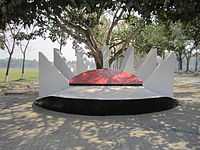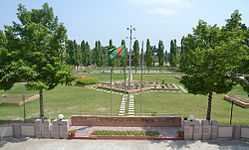Khulna University of Engineering & Technology
| Khulna University of Engineering & Technology | |
|---|---|
| খুলনা প্রকৌশল ও প্রযুক্তি বিশ্ববিদ্যালয় | |
 | |
Former names |
Khulna Engineering College (1967-1986)[1] Bangladesh Institute of Technology (BIT), Khulna (1986-2003)[1] |
| Motto | প্রভু আমায় জ্ঞান দাও |
Motto in English | Oh Lord! Bestow me with Knowledge |
| Established | 1969, granted university status on 2003 |
| Type | Public, Coeducational |
| Chancellor | President of Bangladesh |
| Vice-Chancellor | Dr. Muhammed Alamgir |
| Dean |
Dr. Shibendra Shekher Sikder, Dr. Md. Syed Ali Mollah, Dr. Md. Nurunnabi Mollah |
Academic staff | 202[1] |
| Students | 3460 approx. |
| Undergraduates | 2900 approx |
| Postgraduates | 150 approx |
| Location |
|
| Campus | Urban, 101 acres [1] |
| Nickname | KUET |
| Website |
www |
Khulna University of Engineering & Technology (Bengali: খুলনা প্রকৌশল ও প্রযুক্তি বিশ্ববিদ্যালয়, pronounced: [kʰulna prokowʃɔl o prodʒukt̪i biʃʃobid̪d̪alɔe̯]) commonly known as KUET ([kue̯eʈ]; Bengali: কুয়েট), formerly BIT, Khulna, is a public university of Bangladesh emphasizing education and research on engineering and technology.
Primary focus of KUET is to offer undergraduate academic programs in engineering fields. It also offer post-graduate level degrees and conducts research in basic sciences along with advanced engineering fields. With over two hundred academic stuff it is engaged in teaching some three thousand local and few international students through sixteen academic departments within three faculties.
The university has a 101-acre campus with academic buildings, auditorium complex, halls of residence, teachers dormitory and residences, laboratories, engineering workshops, administrative building, cafeteria, gymnasium and other facilities.
History


Khulna University of Engineering & Technology (KUET), which started functioning from September 2003, is one of the five engineering universities of Bangladesh in higher education, research and development in engineering and technology. This university was established as Khulna Engineering College in 1974; the college was later converted to a degree-awarding autonomous institution called Bangladesh Institute of Technology (BIT), Khulna in July 1986 through a government ordinance (No. XXI, 1986).
The institute was upgraded and renamed as Khulna University of Engineering and Technology in September 2003 under the Khulna University of Engineering and Technology Act, 2003. KUET is financed by the government through the University Grants Commission. The university is an autonomous statutory organization of the Government of Bangladesh. There are statutory bodies like Syndicate, Academic Council, Finance Committee, Planning and Development Committee, Committee for Advance Studies and Research, Academic Committees, etc. for policy- and decision-making on aspects of the university under the frame work of the Act.
Academics
Academic structure
Academic division of KUET is organized in Sixteen departments under three faculties:[2]
Institutes
There are following two Institutes at KUET for advanced research-
- Institute of Information and Communication Technology
- Institute of Disaster Management
Admissions
The admission process in KUET is highly competitive. Each year it opens about 815 seats for undergraduate programs. Only about seven thousand applicants are invited to appear on an admission test. These preliminary filtration is done based on H.S.C. grade points in physics, chemistry and mathematics. The admission test is a standardized test to evaluate students ability to understand concepts on physics, chemistry and mathematics. Admission is offered to successful applicants on merit basis, based on their scores in the test. Students are admitted to a specific undergraduate academic program specializing any of the ten engineering tracks (e.g. CSE, EEE, ME, CE, IEM etc.). Students may not change their track (major) once few weeks of classes are passed.
Admission is open to mainly to Bangladeshi nationals and is based on merit. But, there are a few reserved seats for tribal students - who have to undergo the same admission process. A few seats are also open to some international students. International admission process is separated from local admissions.
Campus
|
Khulna University of Engineering & Technology (KUET) is at Fulbarigate, the northwest part of Khulna City (the third largest south-western divisional city in Bangladesh). The campus is about 15 kilometers from the zero point of Khulna City, which is well-connected to the major city centers by open and wide roads. It is at about 12 km from the Inter-District Bus Terminal and approximately 14 km from the Khulna Railway Station.
The KUET campus covers 101 acres. It is divided into four functional zones: residential zone for the students; residential zone for faculty and staff; academic zone for the academic buildings and workshops; and cultural-cum-social and recreational zone for the students. Being square in shape, the third zone has been at mid-way between the two residential zones to reduce the walking distances.
The main academic building accommodates the teaching and research facilities. Each department is a separate entity with a courtyard around and all the departments constitute an integrated complex. Heavy engineering laboratories are on the ground floor or other separate workshops. Light laboratories, classrooms and project rooms are on the upper floors. Separate offices for every member of the teaching staffs are next to his/her laboratory. Large lecture theaters with the modern accessories and equipment for sound and projection are located in the courtyards between departments for common use.
Library
KUET central library runs in two sections: the General Library and the Reference Library. The General Library provides in-house reading and short-time borrowing of books and other reference material. The Reference Library provides the in-place reading.
All students and faculty can enjoy these facilities for more than 10 hours per working day. Audio-visual systems are available. The General Library system has more than 30,000 books and 5,000 journals and periodicals. A library automation project to modernize and to improve administrative control over the collection of books, journals, proceedings, theses etc. has recently been completed under Higher Education Quality Enhancement Project (HEQEP). Moreover, the library is enriched every year by collecting recent books and journals.
Besides the general library system each academic department maintains a rent-based library from which students can borrow textbooks at a nominal rate for the semester. Recently, KUET library has entered into full automation system.
Medical Center
In campus, Two storyed KUET Medical Center provides primary and basic health care facilities to the students free of charges. Two full-time MBBS doctors and other staffs provide these facilities. For specialized consultation on complicated cases, medical center refers the patients to specialist consultants through ambulance.
Central Computer Center
The Central Computer Center (CCC) of KUET was established in 1988 under the supervision of the department of Electrical and Electronic Engineering with six IBM desktop computers donated by BEXIMCO. To provide fully integrated set of information support to the teaching, research and administrative functions, in 2006 it became us on independent center of KUET in a newly decorated building under the supervision of a nominated chairman from the university.
The CCC has served over the years as the hub for computer-related services in the campus with the commissioning of the university–wide network. The CCC is in a unique position in providing computing and network facilities to the campus for all its IT needs. Now it has strong IT infrastructure with 20 Mbit/s broadband line from BTCL with 1 Mbit/s from other ISP as backup for Internet facility, a router for routing, a firewall for internet security, five high configuration server as mails server, proxy server, database server, seven midlevel configuration of workstations for other servers and backup server, a core switch, several manageable and unmanageable switches for intranet connectivity. It is planned to increase the bandwidth from 10 Mbit/s to 20 Mbit/s and to expand and renovate the optical backbone network including student’s halls of residence and teacher’s residential area secure access of the academic and research materials very soon. All stations are equipped with latest version computers with necessary printing, scanning and CD writing facilities. All students and faculty have access to the network.
Recently KUET has started WiFi Network in its Director of Student Walefare (DSW) and CCC arena for students and at the departments of Electrical & Electronic Engineering (EEE)and Electronics & Communication Engineering (ECE) for teachers.
Student Life
Halls of residence
There are seven residential halls (one female, six male). The administrative heads of a hall are its provost and assistant provost. Usually the halls have a single provost and one or more assistant provost(s).
The residential halls provide several facilities for the students for example hall library, prayer room, TV and recreational room including daily newspapers and magazines etc. Generally each four student live in a room except the two-seat rooms in Amar Ekushey Hall arranged for graduate students. Each of these hall has a dining room (except Amar Ekushey Hall which has two dining rooms) where monthly prepaid lunch and dinner are offered to the students.
See also
References
- ↑ 1.0 1.1 1.2 1.3 "About KUET". KUET. Retrieved 19 April 2011.
- ↑ "Departments of KUET". Retrieved 5 February 2014.
External links
| Wikimedia Commons has media related to Khulna University of Engineering & Technology. |
| ||||||||||||||||||
Coordinates: 22°53′59″N 89°30′09″E / 22.8996895°N 89.5026112°E



